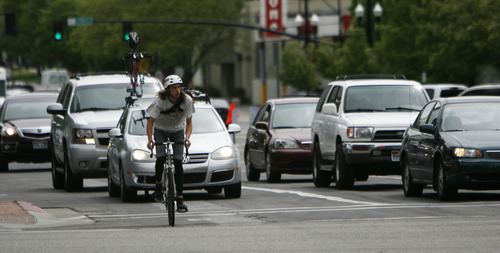This is an archived article that was published on sltrib.com in 2014, and information in the article may be outdated. It is provided only for personal research purposes and may not be reprinted.
As they looked out picture windows at the Salt Lake Valley below to imagine how growth may change it, officials held a summit Tuesday to discuss a possible revolution in transportation to reduce congestion and improve health.
What is that novel change? Encouraging more walking and bicycle riding, what officials like to call "active transportation."
"Active transportation can really yield significant economic, environmental and health benefits," Michael Allegra, president and CEO of the Utah Transit Authority, told the Active Transportation and Health Summit.
It was sponsored by such groups as UTA, the Utah Department of Transportation and the Utah Department of Health. They spent the day talking about efforts from expanding bike-share programs to adding more bike lanes or "bike boulevards" and incorporating active transportation into new road projects.
The summit met atop the Rice-Eccles Stadium tower at the University of Utah. As he opened the meeting, Allegra said many plans for the 2002 Winter Olympics and UTA's TRAX light rail were worked out there amid its stunning valley view, and he hopes the move toward more active transportation will also have roots there.
Allegra said one reason UTA is interested in fostering more safe biking and walking is that it could lead to more use of its buses and trains by helping people with "the first and last mile" between transit and their destination.
"We can get you 90 or 120 miles up and down the Wasatch Front on our commuter rail line," he said. "But if that last mile and a half or two miles isn't easily accessible, the public is still going to drive."
That is a reason why UTA also has been promoting "transit-oriented development" so people can live, work and play near transit stops and perhaps not need a car.
Allegra noted that the U.S. Centers for Disease Control and Prevention suggests that adults walk about 22 minutes a day. "Those who are riding transit are predominantly getting that activity. We're making our community healthier [by] walking and bicycling to transit stations."
He noted that the UTA board recently adopted a goal of doubling transit ridership by 2020. "Our goal here should be doubling" how many people bike and walk, and that could be vital as the Wasatch Front's population is expected to double by 2040.
The summit's keynote speaker was Mia Birk, who directed efforts by Portland, Ore., to turn it into what many call a Mecca for bikers. She is now president of Alta Planning + Design.
She said her own health improved as a graduate student when she started biking to graduate school. She also studied how international cities built around walking and biking could prosper economically and reduce pollution. That all came together for her in a career to stress making U.S. cities healthier with biking.
"It really is a health-care initiative," she said. "Transportation agencies are really looking to health care as a partner in outreach to the community in every facet of how we change people's habits."
Several local agencies already are working to encourage biking and walking. Salt Lake City added miles of bike lanes and started a bike-share program. Salt Lake County just set aside $800,000 for projects that will add 87 miles of bike paths.
UDOT requires its designers to address the needs of bicyclists and pedestrians in all its road projects — which has added numerous new trails and easier-to-maneuver intersections.



